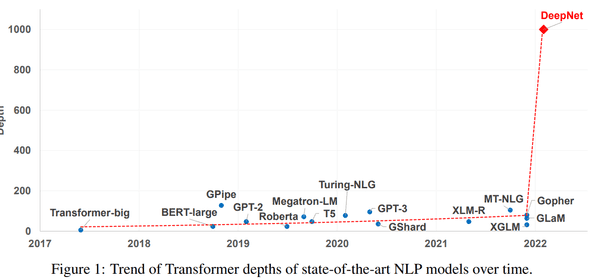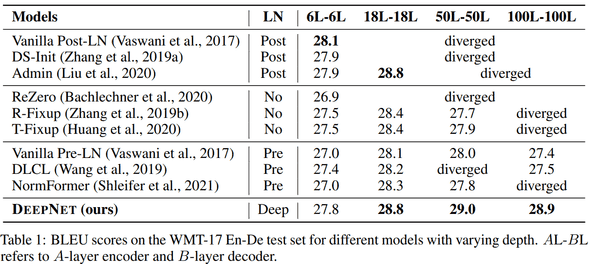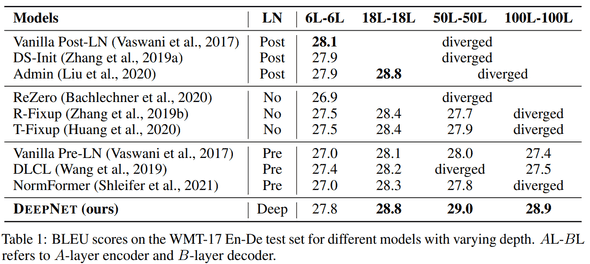TL;DR
최근 논문을 보면 complex 한 architecture를 design 하기보다는 training recipes을 제안하거나 large-scale 모델을 더 stable하게 학습하는 방법 등의 논문들이 많이 나오는 경향입니다 (개인적으로도 좋은 연구 방향이라고 생각함). 이번 microsoft에서 나온 DeepNet은 NLP에서 주로 Transformer를 쌓는데, 어떻게 하면 깊게 쌓아도 모델을 stable하게 학습할 수 있을까?에 대한 연구를 진행했습니다.
아래는 시간에 따른 Transformers depths 변화인데, 최근 deepmind의 Gopher만 해도 ~ 200 depths 인 데 엄청나게 변화가 생겼네요.
Related Work
depth가 깊은 Transformer를 학습할 때 학습을 stablize 하는 여러 논문이 있는데, 관련 있는 최근 논문 하나를 적어보면 Gopher가 있습니다.
Gopher: arXiv
Architecture
논문을 1장 요약하면 아래 이미지로 요약 가능합니다. 기존에는 Post-LN -> Pre-LN scheme을 통해 stability + performance 를 올리는 연구가 있었는데, Pre-LN 는 layer depths가 뒤로 갈 수록 앞 layer보다 gradient norm이 커지면서 performance degradation이 올 수 있다는 점을 이야기합니다.
DeepNet에서는 이 부분은 initializations을 잘해서 해결합니다.
initialization
더 구체적으로 보면 크게 2가지인데,
- residual connection 하는 부분에서 input 에 대해 scaling
- 거의 비슷한데 (기존과 같이 xavier normal), 일부 layer에 gain 수정
는 depth가 깊어질수록 커지고, (gain) 은 작게 사용하네요.
formula 로 일반화 하면 아래와 같습니다.
- : scaling factor at the residual connection
- : -th Transformer sub-layer (e.g. FFN or MSA) with parameter ()
Performance
다양한 NLP task와 benchmarks를 진행했는데, large-scale 에서 diverge하지 않고 더 깊게 쌓았을 때 더 좋은 성능을 보여주고 있습니다.
BLEU score
BLEU score by depths
다른 methods 는 18 dethps (약 large recipe) 정도만 돼도 diverge 하네요.
Conclusion
갠적으로도 training recipe 를 통한 성능 향상이나 이런 느낌의 연구들을 좋아하는데, 1000 depths large-scale transformer 를 간단한 방법으로 stable 하게 학습할 수 있다는 점에 재밌는 거 같습니다.
결론 : 굳굳



